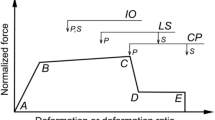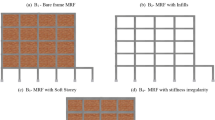Abstract
This study is focused on reinforced concrete (RC) structures located in the neighbourhood of “Alvalade” (Lisbon). They were mainly constructed during the 50s, prior to the application of more demanding seismic codes. Two case studies of two structural configurations have been selected to be analysed: framed and wall-frame buildings. They are representative of Lisbon’s current building stock and present a considerable seismic vulnerability. Typical irregularities identified in this study, which can worsen the seismic performance of these buildings, are: (i) the heterogenic distribution of infills, and; (ii) the irregular height of the columns. The main goal of this research is to analyse how these irregularities affect the seismic behaviour of these representative RC buildings. To do so, nonlinear static analyses have been carried out, and the N2 method and its extended version has been considered. Different versions of the buildings have been defined varying the position of the infills and the height of the columns and the walls. Results have shown that the buildings with irregularities in height present lower values of stiffness and strength. It has been proved that the infills increase the models’ overall stiffness and strength. However, if they are no regularly distributed the performance can be worsened. It has been concluded that retrofitting measures should be taken into account to prevent the shear failure of the RC building structures analysed to comply with the safety requirements of the EC8-3.
Access this chapter
Tax calculation will be finalised at checkout
Purchases are for personal use only
Similar content being viewed by others
References
Silva V, Crowley H, Varum H, Pinho R, Sousa L (2015) Investigation of the characteristics of Portuguese regular moment-frame RC buildings and development of a vulnerability model. Bull Earthq Eng 13(5):1455–1490. https://doi.org/10.1007/s10518-014-9669-y
Environmental Systems Research Institute (ESRI) (2011) ArcGIS desktop: release 10
Diário do Governo (1983) Regulamento de Segurança e Acções para Estruturas de Edifícios e Pontes (RSA), Decreto-Lein. 235/83, Lisbon, Portugal. (in Portuguese)
Couto R, Requena-García-Cruz, M, Bento R, Morales-Esteban A (2020) Seismic capacity and vulnerability assessment considering ageing effects. Case study: three local Portuguese RC buildings. Bull Earthq Eng. https://doi.org/10.1007/s10518-020-00955-4
De Stefano M, Pintucchi B (2008) A review of research on seismic behaviour of irregular building structures since 2002. Bull Earthq Eng 6(2):285–308. https://doi.org/10.1007/s10518-007-9052-3
Stathopoulos KG, Anagnostopoulos SA (2005) Inelastic torsion of multistorey buildings under earthquake excitations. Earthquake Eng Struct Dynam 34(12):1449–1465. https://doi.org/10.1002/eqe.486
Chintanapakdee C, Chopra AK (2004) Seismic response of vertically Irregular frames: response history and modal pushover analyses. J Struct Eng 130(8):1177–1185. https://doi.org/10.1061/(ASCE)0733-9445(2004)130:8(1177)
Dolšek M, Fajfar P (2008) The effect of masonry infills on the seismic response of a four storey reinforced concrete frame-a probabilistic assessment. Eng Struct 30(11):3186–3192. https://doi.org/10.1016/j.engstruct.2008.04.031
CEN (2004) Eurocode 8: design of structures for earthquake resistance—part 1: general rules, seismic actions and rules for buildings. European Committee for Standardization. 1 (English): 231. (Authority: The European Union per Regulation 305/2011, Directive 98/34/EC, Directive 2004/18/EC)
McKenna F, Fenves G, Scott M (2007) OpenSees: open system for earthquake engineering simulation. Pacific Earthquake Engineering Research Center, University of California, Berkeley. http://opensees.berkeley.edu
Popovics S (1973) A numerical approach to the complete stress-strain curve of concrete. Cem Concr Res 3(5):583–599. https://doi.org/10.1016/0008-8846(73)90096-3
Filippou FC, Popov EP, Bertero VV (1983) Effects of bond deterioration on hysteretic behaviour of reinforced concrete joints. Report to the National Science Foundation, Berkeley, California. http://www.ce.berkeley.edu/~filippou/Research/Publications/Reports/EERC-83-19.pdf
Caruso C, Bento R, Sousa R, Correia AA (2019) Modelling strain penetration effects in RC walls with smooth steel bars. Mag Concr Res 71(17):894–906. https://doi.org/10.1680/jmacr.18.00052
Celarec D, Ricci P, Dolšek M (2012) The sensitivity of seismic response parameters to the uncertain modelling variables of masonry-infilled reinforced concrete frames. Eng Struct 35:165–177. https://doi.org/10.1016/j.engstruct.2011.11.007
Panagiotakos TB, Fardis MN (1996) Seismic response of infilled RC frame structures. In: Proceedings of the 11th world conference on earthquake engineering, pp 1–8
European Union (2005) Eurocode-8: design of structures for earthquake resistance. Part 3: assessment and retrofitting of buildings. Belgium
Acknowledgements
The authors would like to acknowledge the financial support of Fundação para a Ciência e a Tecnologia (FCT, Ministério da Educação e Ciência, Portugal) through the scholarship BL105/2019 through the FCT Research Program: MitRisk—Framework for seismic risk reduction resorting to cost-effective retrofitting solutions, POCI-01-01456-Feder-031865. In addition, the scholarship provided by the VI-PPI of the University of Seville is acknowledged.
Author information
Authors and Affiliations
Corresponding author
Editor information
Editors and Affiliations
Rights and permissions
Copyright information
© 2022 The Author(s), under exclusive license to Springer Nature Switzerland AG
About this paper
Cite this paper
Requena-Garcia-Cruz, MV., Couto, R., Bento, R., Morales-Esteban, A. (2022). Seismic Assessment of RC Buildings Considering the Influence of Vertical Irregularities: Framed and Wall-Frame Structures. In: Bento, R., De Stefano, M., Köber, D., Zembaty, Z. (eds) Seismic Behaviour and Design of Irregular and Complex Civil Structures IV. Geotechnical, Geological and Earthquake Engineering, vol 50. Springer, Cham. https://doi.org/10.1007/978-3-030-83221-6_24
Download citation
DOI: https://doi.org/10.1007/978-3-030-83221-6_24
Published:
Publisher Name: Springer, Cham
Print ISBN: 978-3-030-83220-9
Online ISBN: 978-3-030-83221-6
eBook Packages: Earth and Environmental ScienceEarth and Environmental Science (R0)




